Related Research Articles

The Piper PA-28 Cherokee is a family of two-seat or four-seat light aircraft built by Piper Aircraft and designed for flight training, air taxi and personal use. The PA-28 family of aircraft comprises all-metal, unpressurized, single piston-engined airplanes with low-mounted wings and tricycle landing gear. They have a single door on the right side, which is entered by stepping on the wing.
In aviation, a go-around is an aborted landing of an aircraft that is on final approach or has already touched down. A go-around can either be initiated by the pilot flying or requested by air traffic control for various reasons, such as an unstabilized approach or an obstruction on the runway.

On 25 July 2000, Air France Flight 4590, a Concorde passenger jet on an international charter flight from Paris to New York, crashed shortly after takeoff, killing all 109 people on board and four on the ground. It was the only fatal Concorde accident during its 27-year operational history.
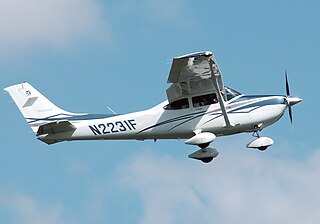
The Cessna 182 Skylane is an American four-seat, single-engined light airplane built by Cessna of Wichita, Kansas. It has the option of adding two child seats in the baggage area.

Air Transat Flight 236 was a transatlantic flight bound for Lisbon, Portugal, from Toronto, Canada, that lost all engine power while flying over the Atlantic Ocean on August 24, 2001. The Airbus A330 ran out of fuel because of a fuel leak caused by improper maintenance. Captain Robert Piché, 48, an experienced glider pilot, and First Officer Dirk DeJager, 28, glided the plane to a successful emergency landing in the Azores, saving all 306 people on board. Most of the passengers on the flight were Canadians visiting Europe or Portuguese expatriates returning to visit family in Portugal. This was also the longest passenger aircraft glide without engines, gliding for nearly 75 miles or 121 kilometres. Following this unusual aviation accident, this aircraft was nicknamed the "Azores Glider".
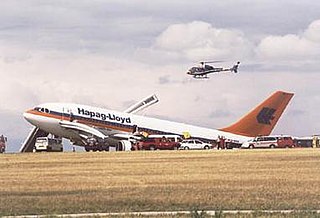
Hapag-Lloyd Flight 3378 (HF-3378) was a passenger service operated by Hapag-Lloyd Flug from Chania, on the island of Crete, Greece, to Hannover, Germany. On 12 July 2000, the aircraft flying the route, an Airbus A310-304, registration D-AHLB, with 143 passengers and 8 crew on board, set off for Hannover leaving the landing gear fully extended, as a precaution, since a malfunction had prevented its proper retraction after take-off. The plane eventually ran out of fuel while attempting a diversion to Vienna, crash-landing just short of runway 34. No fatalities resulted, although the aircraft was written off.
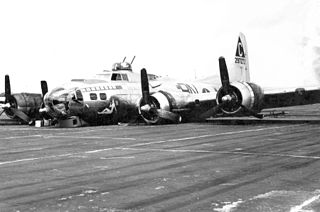
A belly landing or gear-up landing occurs when an aircraft lands without its landing gear fully extended and uses its underside, or belly, as its primary landing device. Normally the term gear-up landing refers to incidents in which the pilot forgets to extend the landing gear, while belly landing refers to incidents where a mechanical malfunction prevents the pilot from extending the landing gear.
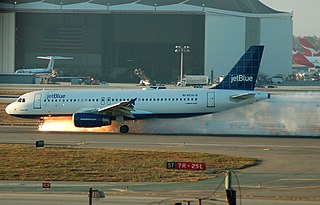
JetBlue Flight 292 was a scheduled flight from Bob Hope Airport in Burbank, California, to John F. Kennedy International Airport in New York City. On September 21, 2005, Captain Scott Burke executed an emergency landing in the Airbus A320-232 at Los Angeles International Airport after the nose gear jammed in an abnormal position. No one was injured.

Oakland County International Airport is a county-owned public-use airport located in Waterford Township, Oakland County, Michigan, United States. The airport is located approximately one mile from the center of Waterford Township and Oakland County. It is included in the Federal Aviation Administration (FAA) National Plan of Integrated Airport Systems for 2017–2021, in which it is categorized as a non primary commercial service facility.

Jackson County Airport, also known as Reynolds Field, is a county-owned, public-use airport located two nautical miles (3.7 km) west of the central business district of Jackson, in Jackson County, Michigan, United States. It is a class D airport with operating control tower. It is included in the Federal Aviation Administration (FAA) National Plan of Integrated Airport Systems for 2017–2021, in which it is categorized as a regional general aviation facility.

In an internal combustion engine, fuel starvation is the failure of the fuel system to supply sufficient fuel to allow the engine to run properly, for example due to blockage, vapor lock, contamination by water, malfunction of the fuel pump or incorrect operation, leading to loss of power or engine stoppage. There is still fuel in the tank(s), but it is unable to get to the engine(s) in sufficient quantity. By contrast, fuel exhaustion is an occurrence in which the vehicle in question becomes completely devoid of usable fuel, with results similar to those of fuel starvation.
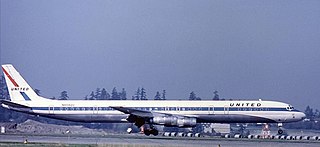
United Airlines Flight 173 was a scheduled flight from John F. Kennedy International Airport in New York City to Portland International Airport in Portland, Oregon, with a scheduled stop in Denver, Colorado. On December 28, 1978, the aircraft flying this route ran out of fuel while troubleshooting a landing gear problem and crashed in a suburban Portland neighborhood near NE 157th Avenue and East Burnside Street, killing 10 on board.

Paraburdoo Airport is an airport serving Paraburdoo, a town in the Pilbara region of Western Australia. The airport is located 5 nautical miles northeast of Paraburdoo. It also serves the town of Tom Price, with bus services completing the extra 71 km to Tom Price.

Malév Hungarian Airlines Flight 262 was a flight from Budapest Ferihegy International Airport to Thessaloniki International Airport. On 4 July 2000, a Tupolev Tu-154, belonging to Malév Hungarian Airlines, used on this flight performed a gear-up touchdown during the landing at Thessaloniki, skidded on the runway, but was able to take off and land normally after a go-around. No injuries were reported.
BUMMMFITCHH is one form of a mnemonic used by pilots to remember the sequence of actions required when an aeroplane is on approach to land. A shorter version for simple aircraft is BMFFH; many variations exist for different aircraft types.

Custer Airport, sometimes referred to as Monroe Custer Airport, is a city-owned public airport located in the city of Monroe in Monroe County, Michigan. The airport opened in November 1946 and was named for George Armstrong Custer, who spent much of his early life in Monroe. It is included in the Federal Aviation Administration (FAA) National Plan of Integrated Airport Systems for 2017–2021, in which it is categorized as a local general aviation facility.

The Tecnam P2006T is an Italian high-winged twin-engined all-metal light aircraft, built by Costruzioni Aeronautiche Tecnam based in Capua, Italy, near Naples. The P2006T received airworthiness certification in the European Union by EASA under CS23 in 2003, type certification in 2009, and Federal Aviation Administration FAR Part 23 certification in 2010.

On 15 March 1974, Sterling Airways Flight 901, a Sud Aviation Caravelle operated by Sterling Airways, experienced a landing gear failure as it was taxiing for take-off. The right main landing gear collapsed, which caused the right wing to contact the runway, rupturing a fuel tank and igniting the spilt fuel. The fire killed 15 passengers and injured 37 passengers and crew. The aircraft had been chartered by tour company Tjæreborg to take tourists around Asia, and was on the way back to Copenhagen when the accident happened. The accident came only two years after the crash of Sterling Airways Flight 296.

On 27 January 2020, Caspian Airlines Flight 6936 overran the runway on landing at Mahshahr Airport, Iran, on a domestic flight from Tehran. All 144 people on board survived, with two injured.
References
- ↑ "Mnemonic Reminders". Feb 2000. Retrieved 27 July 2017.
- ↑ National Transportation Safety Board (February 2002). "NYC02LA061" . Retrieved 17 March 2010.
- ↑ King Schools (2010). "KwikVote Results". Archived from the original on October 23, 2007. Retrieved 17 March 2010.
- ↑ NASA (January 2004). "Checklist Checkup" . Retrieved 2010-02-26.
- ↑ Stoller, Joel. "Preflight prep" (PDF). Aircraft Owners and Pilot Association.
- ↑ Love, Michael Charles (June 1995). Better takeoffs & landings. McGraw-Hill, Inc. p. 53. ISBN 0-07-038805-9 . Retrieved 14 December 2010.
- ↑ Thomas P. Turner. "Leading Edge #4: Checklists and Flows" . Retrieved 2011-02-20.